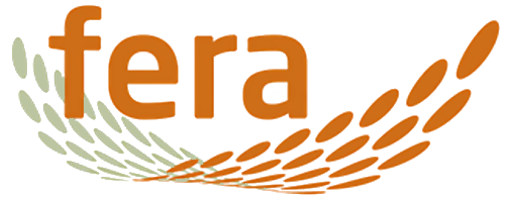Conveying scientific evidence from drones to decision makers
The agri-food research company Fera Science has developed a GIS-based web app to share high resolution imagery from an Unmanned Aerial System with a range of government and commercial clients. The solution gives decision makers a deeper understanding of complex environmental and agricultural challenges, so they can plan more effectively to protect our natural resources and food security.
A root vegetable grower can identify inconsistencies in crop sowing to increase future food production
A government agency can survey and protect endangered trees more cost effectively
A large landowner can plan a more sustainable business expansion, while improving safety
The Challenge
In a world challenged by population growth, pollution and climate change, Fera Science provides accurate, scientific evidence to support critical decisions in the agriculture and environment industries. It delivers research data and advice for 7,500 government and commercial organisations, helping them to increase food production, ensure water quality, maintain food nutrition and sustain our natural resources.
Every year Fera undertakes over 600 research assignments and, in the Land Use and Sustainability Team specifically, nearly half of all projects involve the collection and analysis of remotely sensed imagery. To supplement the use of imagery from satellites and manned aircraft, Fera acquired an Unmanned Aerial System (UAS), capable of taking higher resolution spatial images at a significantly lower cost than a piloted aircraft. However, to optimise the value of its new UAS services, Fera needed a way to make the high quality imagery and analysis available to clients, in a format that they could interrogate, interpret and ultimately use to make better-informed decisions.
Esri’s Web AppBuilder enables us to produce web apps easily in-house, without the need for support and bespoke code from specialist app developers
Lee Butler – GIS Specialist, Land Use and Sustainability Team, Fera
The Solution
Fera has been using solutions from Esri’s ArcGIS platform for many years and has an Enterprise Licence Agreement with Esri UK that gives it unlimited access to Esri’s full software portfolio. Taking advantage of Esri’s ArcGIS Web AppBuilder, the company designed a web app that allows clients to view data from the UAS, zoom in to the full resolution of the imagery, turn on map layers and view attributes specifically relating to their projects. A typical 25-minute UAS flight generates over 6GB of data, comprising up to 3,000 individual photographs that are mosaicked together to create a single, seamless image.
The simplicity of ArcGIS Web AppBuilder means that Fera can quickly build a bespoke web app for each client to include ‘widgets’ that allow decision makers to perform analysis tasks, such as counting trees or crops in a custom-defined area. “Esri’s Web AppBuilder enables us to produce web apps easily in-house, without the need for support and bespoke code from specialist app developers,” says Lee Butler, a GIS Specialist within Fera’s Land Use and Sustainability Team.
The ArcGIS web apps allow our clients to interact with, interrogate and analyse the imagery collected by the drone, which they couldn’t do previously
Lee Butler – GIS Specialist, Land Use and Sustainability Team, Fera
The Benefits
An efficient and high quality service for clients
The use of ArcGIS web apps enables Fera to deliver a UAS imaging service for its clients that is as cutting-edge and professional as its scientific research methods. Furthermore, as Fera no longer has to manually produce paper and pdf maps, it saves up to 10 hours every month and can deliver its UAS imagery to clients more promptly. “The ArcGIS web apps allow our clients to interact with, interrogate and analyse the imagery collected by the UAS, which they couldn’t do previously,” Butler says. “It allows them to acquire a far deeper understanding from the aerial imagery and gain added value from our services.”
Increased agricultural crop yields
One of the first companies to benefit from Fera’s web app is an agricultural company that grows potatoes and root vegetables. After the UAS flew over two large potato crop fields, the client used the web app to assess planting efficiency and automatically count plants, so that it could estimate yield more accurately and provide better forecasts to its customers. Using the ArcGIS web app, the client identified unexpected gaps in fields, where the planting machinery had not planted in a uniform manner throughout the crop and at the start of planting rows. Enlightened, it is now using this new information to review its planting techniques to increase crop yields for next year.
More cost efficient environmental surveys
Another of Fera’s clients, a government agency, is using the web app to help it monitor the outbreak of pests and disease in trees more cost efficiently and protect British woodlands. The UAS flies over areas where there are confirmed or suspected incidents of tree disease. The imagery is then processed and classified to tree species using imagery classification techniques. Tree inspectors can then view the imagery using the ArcGIS web app to identify the precise locations of tree species that are susceptible to that particular disease. Using this newly-gained insight, inspectors can plan their surveys more effectively to save time and money. They can even access the web app in the field using web-connected tablets, to help them find potentially infected trees more quickly.
Safe and sustainable land use
The ArcGIS web app can in fact be invaluable in supporting the use of UAS imagery in all kinds of land use projects. For instance, it is currently being used by a quarrying company in County Durham, where the UAS captured images over a 174 hectare site. Senior executives at the quarry use the ArcGIS web app to better interpret imagery in 2D and 3D and make decisions relating to the ongoing, sustainable use and future expansion of the site. They also use the app to brief visitors and members of staff about the locations of potential hazards, which helps to improve health and safety.



